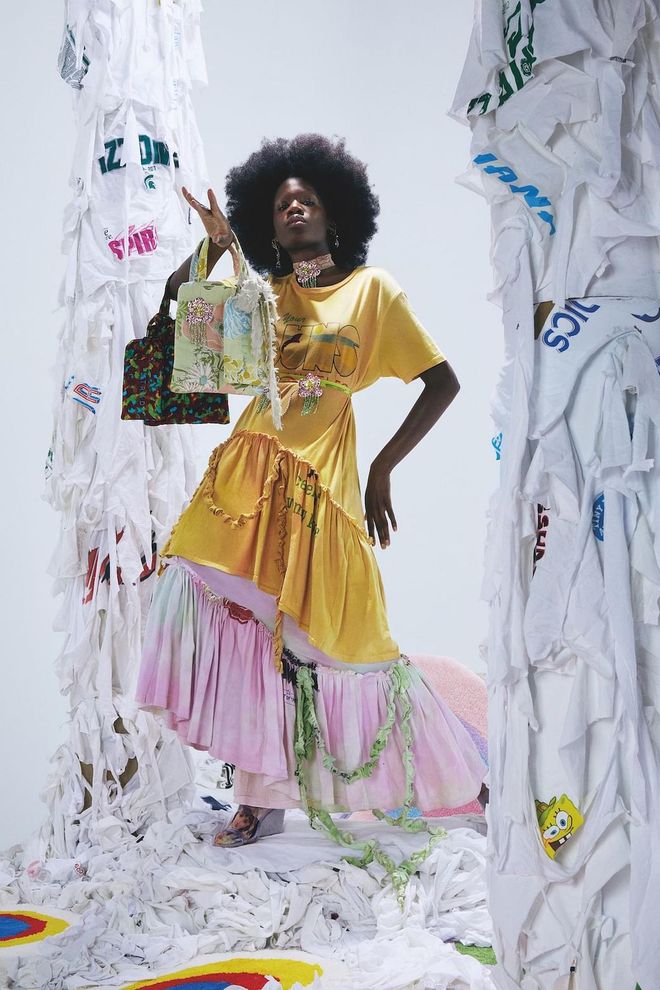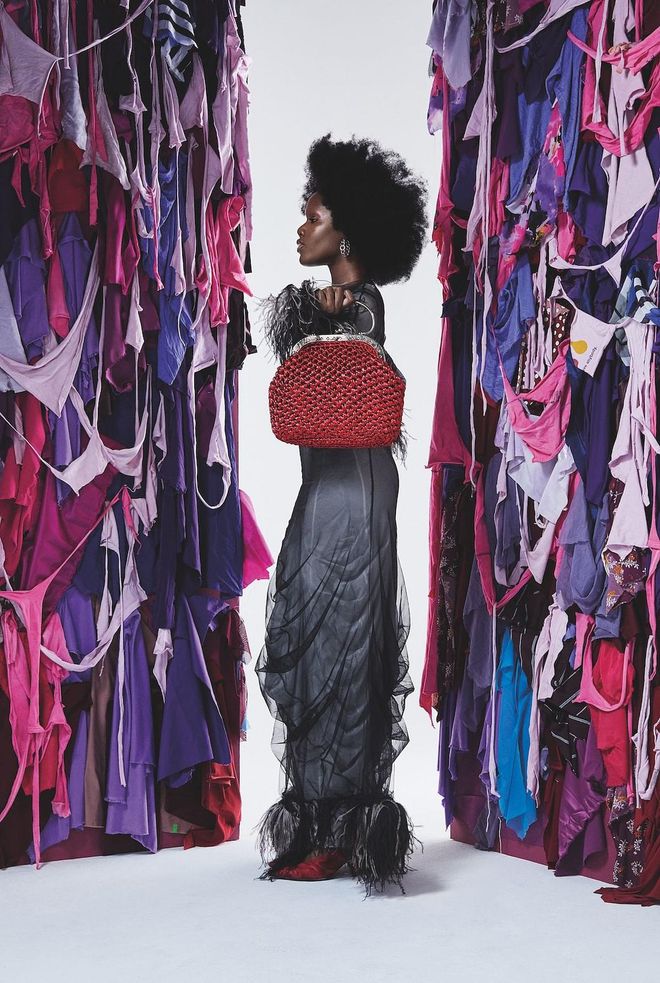

Cape; top; turtleneck; trousers, all by Prada. (Photo: Charlie Engman)
Last spring, during the first days of sheltering at home, Proenza Schouler’s Jack McCollough and Lazaro Hernandez realised that they were in a bind. The world’s premium fabric mills, many based in the areas of northern Italy hardest hit by the pandemic, were all closed until further notice. How could a luxury fashion label design a new collection without any new fabric? After innumerable Zoom sessions with suppliers, they decided to use bolts of deadstock fabric left over from past seasons. “We had this vast archive of fabrics from the past decade and we really tapped into that—and in a strange way, it forced us to be more creative,” recalls Hernandez. “Ninety percent of the spring 2021 collection is made from archival fabrics that have been reworked in different ways.” Meeting the challenge with an optimistic throw-on-and-go collection of rib-knit separates and oversize tailoring in earthy tones, the duo also achieved their long-held goal of reducing waste.
Related article: Meet Tove & Libra, The Sustainable Brand That Aims To Make Fashion Better
“This process has taught us a lot that we plan to take forward into future seasons,” McCollough explains. “We keep saying, ‘Wouldn’t it be sad if we got out of this and went back to life as it was?’ It has made us think outside the box.”
That ability to pivot was required of nearly every design studio across the world this season, as brands grappled with unprecedented supply chain interruptions caused by Covid-19. It meant that they had to reconsider conventional beliefs about what constitutes high fashion. Upcycling, the process of reusing existing materials, used to conjure up crafty, scavenged visions of Mad Max—the opposite of luxury. Until recently, less than 1 percent of the fabric produced by the fashion industry was recycled into new garments, according to a 2017 report by the Ellen MacArthur Foundation, a circular economy think tank, contributing to an estimated loss of US$500 billion worth of materials each year. This is an industry defined by its relentless quest for the new and the next, with labels churning out four or more collections per year, each made from new and different fabrics, the leftovers of which almost immediately become, you guessed it, deadstock.

T-shirt dresses; pin (worn as choker); bags; ribbon and pin (worn as belt), Collina Strada. Ear cuffs, Alexander McQueen. Wedge, Maryam Nassir Zadeh. (Photo: Charlie Engman)
Proenza Schouler was not alone in raiding its storage unit this season. At Alexander McQueen, eagle-eyed fans may have spotted the sweet pea fabric from the label’s pre-spring 2016 collection on shoulder bags, while much of the suiting and sultry lace dresses were produced with deadstock fabrics. Domenico Dolce and Stefano Gabbana also took a trip down memory lane for their Dolce&Gabbana spring 2021 Sicilian Patchwork collection. Squares of shimmering brocades, striped cottons, and leopard-print and polka-dot chiffons sourced from their fabric archives blended many of the brand’s hallmarks. “The lockdown reminded us that we could creatively reuse what we had by transforming it and that everything can last forever,” says Gabbana.
Related article: Sustainable Fashion: New Designers Are Rethinking The Way They Create
For Chloé’s newly minted Creative Director Gabriela Hearst, who has used deadstock since her first runway collection for her namesake brand in 2017, the crisis has offered something of a litmus test. “Limitations always expose your taste and point of view,” she says. “Let’s be honest here, repurposed fabric can look like a hot mess. But if it’s done right, you shouldn’t even realise that the fabric hasn’t come straight from a mill.” She notes the shift in attitude: “When we started repurposing materials for our first show, it wasn’t spoken of in the luxury market and I got in trouble with one of our mills because they felt it wasn’t the right language. Thankfully, that is all changing now.”

Skirts, Chopova Lowena. Earrings; necklaces; shoes, Dolce&Gabbana. (Photo: Charlie Engman)
Mill shutdowns also inspired innovative uses of unexpected materials. Take Balenciaga’s Creative Director Demna Gvasalia’s “fur” coat, for instance, which is made from surplus shoelaces. Or his dress created from reused basketball nets (instantly recalling Cristóbal Balenciaga’s iconic fisherman’s net dress), or the sculptural moto jacket made from patchworked boots complete with rivets and buckles.
Gvasalia, of course, spent time earlier in his career at Maison Margiela, where that kind of material innovation has always been core. During the label’s early days, Martin Margiela used found materials to create entirely new garments—a butcher’s apron transformed into a dress, for example. Creative Director John Galliano continued to build on that legacy this season with his Recicla refurbished vintage pieces, which include lovingly restored wicker bags, lace tops and tango pumps.
Related article: 8 Asian Sustainable Fashion Brands Making A Splash In The Industry
At Coach, Executive Creative Director Stuart Vevers personalised archival bags from the brand’s 1960s Bonnie Cashin era with stitched monikers, and added butterfly embroideries and rhinestones to Levi’s 501 jeans. He named his spring collection “Coach Forever”, to underline that it’s an amalgam of past, present and future.
Other brands made investments in higher-tech upcycling methods, such as creating fabric from regenerated fibres. Prada’s Re-Nylon project—a collection of the label’s signature nylon bags crafted from nylon fabric made from recycled textiles and ocean plastic—expanded to ready-to-wear. Some of the season’s coveted clutch capes are made from Re-Nylon, literally turning trash into treasure. “With Re-Nylon, we can create products without using new resources, highlighting our continued efforts towards promoting responsible retail,” says Miuccia Prada’s son Lorenzo Bertelli, who is also the Prada Group’s Head of Marketing and Corporate Social Responsibility. “We’re on track concerning the conversion of the entire virgin nylon production into regenerated nylon by the end of 2021.”
Related article: 9 Places To Shop For Sustainable Fashion In Singapore
Another eco silver lining is that the number of pieces heading into production has been drastically reduced, which will lead to less waste. “Post-Covid, those who can afford the ultimate luxury will want things that are special and closer to one-offs, and it won’t be so much about a $3,000 dress that’s available around the world,” says Hassan Pierre, co-founder of Maison de Mode, a luxury fashion retailer for high-end, environmentally responsible fashion.

Dress; bag; shoes, Maison Margiela. Hoop earring, Alexander McQueen. (Photo: Charlie Engman)
Green fashion trailblazer Stella McCartney agrees. “Often, we can only create limited-edition or one-off pieces because of the small quantities of leftover fabric and stock we have. That said, it also means we’re making rare pieces that women can cherish, truly like wearable art.” One such collector’s piece, the Gabriela dress, combines strips of fabric from nine of the brand’s ready-to-wear collections. “I used to be the only conscious fashion brand in the room,” McCartney says of her two decades spent campaigning for greater responsibility in luxury fashion. “And now I love to see other designers re-evaluate what their purpose is.”
Whether this wave of pandemic-induced environmental responsibility will last is the question concerning many advocates of conscious design. Sustainability consultant Anna Brismar, who coined the term “circular fashion” in 2014, has her reservations. “Disruptions will result in some embracing the need for more sustainable and circular practices, but many companies will likely revert to business as usual,” she predicts. The issue there, explains Pierre, is that “the climate emergency isn’t a trend; it’s not going away. Protecting our environmental future is fundamental to future-proofing the success of a brand; it’s not just a marketing ploy.”
Related article: Meet Pangaia, The Eco-Friendly Fashion Label Taking Over Instagram
For many brands though, especially the younger, more environmentally conscious set, the pandemic did not prove to be as disruptive. “We make everything in small ateliers in Bulgaria, and our skirts are made in such small runs that it didn’t slow us down,” says Emma Chopova of London-based label Chopova Lowena, known for its accordion- pleated kilts made from old pillowcases and aprons. In Paris, Lamine Kouyaté of XULY.Bët knit together offcuts to create a multicoloured, tasselled mini skirt to open his collection, while Kevin Germanier employed a zero-waste pattern technique, cutting all of his dresses from humble rectangles. In New York, Hillary Taymour of Collina Strada designed a host of trippy printed shirts, tanks, and dresses made of t-shirts sourced from Kantamanto Market in Ghana, and Eckhaus Latta cut deadstock crochet and doilies to make homespun skirts and dresses. In Rome, Stella Jean saw the challenge as a matter of resistance. “On the first day of the shutdown, I contacted all of my artisans, most of whom are women, and said, ‘Will you join me and carry on?’ I’m no good at making cake or pizza, so for me, there was no choice.” The result was a small-run spin-off collection created from upcycled men’s shirt fabrics, hand-painted and hand-embroidered, preserving local techniques.
The one takeaway from studios, both big and small, has been the renewed energy and optimism that the new limits have engendered. McCartney’s final reflection seems particularly apt. “This time has allowed me to return more focused on what matters,” she says. “I can see clearly there is so much overproduction and overconsumption, and a relentless drive for newness, and I hope that more circular thinking can show that you can get that sense of novelty in other ways that are kinder to our planet.” Welcome to new 2.0: Fresh, exclusive and environmentally attentive, and with just a sprinkle of déjà vu.
Photographed by Charlie Engman
Styled by Becky Akinyode
Model: Oyinda
Makeup: Tracy Aljafora using Bobbi Brown.
Hair: Tashana Miles/Chair Beauty Loft using Chair Beauty
Production: Bennett & Clive
Set designer: Javier Irigoyen